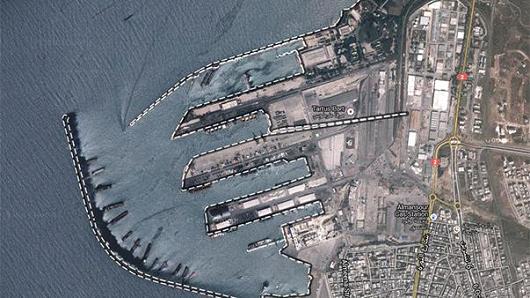Russia Inside Syria
Now we learn Russia is building an airbase in Latakia, Syria. Also see here. The United States may be attempting to withdraw from the world, but Russia is expanding to fill the vacuum. Ostensibly, they are there to fight ISIS. They are indeed there to do exactly that, but they are also there to support a client of Iran, the President of Syria, Bashar al-Assad, and thereby help out their allay Iran. In addition, it is not just Assad’s regime that is threatened, but Russia’s Syrian former naval resupply base in the port of Tartus, shown in the photo above, as well. As another goal, Russia may be seeking more permanent bases in Syria.

Image Credit: Google Maps/Nations Online Project
Russia actually evacuated its Tartus naval base in 2013 because of possible threats from rebels in Syria’s civil war. Unsurprisingly, Syria has been eager to lure them back, and Russia has shown some interest. In addition the website stratfor.com repeated an Interfax report on a source from the Russian Navy Main Staff. The source said that the Navy Staff had not yet decided on turning the Tartus facility into a full-fledged naval base, because of security concerns. Russia does have an alternative with Cyprus ports, but if they could reopen the base in Tartus, Russian naval and military options in the Mediterranean would increase. In fact, if Russia became the suzerain of Syria, they could place a military buffer between the Sunni jihadists to the East and the Mediterranean. If, with the help of their ally Iran, they could actually defeat ISIS, Russia and Iran could end up with effective control of both Syria and Iraq. They would then be poised for more adventures in the Middle East.
Without either Iranian or Russian support, Bashar al-Assad’s regime probably would be consumed soon by ISIS. Robert Fisk, writing for The Independent in Great Britain, had this diagnosis of the Assad regime’s health.
It’s a dangerous equation in the Syrian war that the further you are from Damascus, the more Bashar al-Assad’s regime seems doomed. And the more you drive around the vast area still held by government forces – and I’ve just completed around 1,100 miles of mountains, desert and battle fronts – the more you realise that the war will go on. And on. And that the Syrian army, outgunned and at times frighteningly outnumbered by its Islamist enemies, is not about to collapse.
Fisk then goes on to write about just why we should expect the Syrian army to collapse.
- The logistics of ISIS are better than those of the Syrians, presumably because they have captured so many U.S. vehicles from the Iraqis.
- ISIS has captured a large number of wire-guided TOW and Milan anti-tank missiles. They have so many they can afford to shoot three or four missiles at a single Syrian tank to destroy it.
- At Palmyra, just before the Syrian forces were compelled to retreat, the Syrians discovered that ISIS fighters had thousands of tactical body-armour vests, presumably also captured from the Iraqis, as well as thermal (anti-aircraft?) missiles.
- ISIS consistently outnumbers Syrian forces on the battlefield and attacks on such broad fronts the Syrian army lacks the manpower to withstand the attacks.
Not mentioned by Fisk is the fact ISIS has captured every single one of Syria’s oil fields, denying Syria both domestically produced fuel and income from oil sales. The capture of these oil fields also gives ISIS an additional source of funds.
Without outside help from Russia and Iran, there seems little doubt that ISIS could conquer all of Syria. In the same report by Robert Fisk cited above, Fisk writes about Iranian soldiers he met on battlefields after the fighting. Fisk wrote he met them in twos and threes, apparently after they were soundly beaten. From what he reported, they were smart and well-educated – but just now learning how to fight ISIS. Without this Iranian presence however, the Syrian position would be far more desperate.
ISIS is certainly facing little opposition from U.S. and allied air strikes inside either Syria or Iraq. A recent report revealed a grand total of 21 air strikes during this last weekend of September 5-6, 2015. There were a total of 17 strikes inside Iraq, and only four against ISIS inside Syria. During the Vietnam war, there were hundreds of airstrikes every day, and in tactical engagements there usually was one or more Army forward observers or Air Force liaisons on the ground helping to direct the strikes. I can attest from personal experience, this ground direction was essential, not only for the efficient destruction of the enemy, but for the protection of your own troops. The current American air campaign against ISIS with an insignificant number of strikes without U.S. ground air control amounts to pinpricks that can do no more than annoy ISIS commanders.
With this background the promise of a more effective Russian air campaign and the additional reinforcement by Iranian soldiers must seem like a godsend to Bashar al-Assad. If they are sufficient to turn the tide against ISIS in Syria, there is no reason that they could not be applied in Iraq, as Shiite Iraq seems more and more to be a client of Shiite Iran. What would then happen after a final ISIS defeat in these circumstances? It would seem likely that both Syria and Iraq would be totally under the thumb of Russia and Iran (remember they are allies with each other and China). Russia and Iran would then be poised for more mischief in the Middle East.
Views: 2,195





























